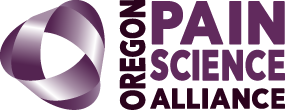Resource Elements
- Pain doesn’t ’live’ in our tissues.
- A therapist’s hands aren’t magic.
- Incorporating pain science concepts into therapy practice is to a ‘both new and old’ pattern.
- Make the patient the center of the healthcare team.
- Ask a lot of questions.
- He cites 4 tips related to modifying beliefs and 2 problems in helping colleagues restructure their understanding.
- He recommends 7 books that were the basis for his change in belief and practice.
Tyler recalls his early understanding of pain, that it was part of the human condition and pain was something that lived in our tissues. He had traditional biomedical training in physical therapy including nociceptive fibers and the gate theory which focused on treatments to essentially shut the pain gate by overwhelming the skin with robust sensory stimulus The presence of pain meant there was damage in the tissue. Pain was a one-way signal in the nervous system.
In his first internship after therapy school he was introduced to ‘Explain Pain’ by Butler and Moseley but wrote it off because he was focused on manual therapy. He thought he had magic hands and could fix anyone with just the right manipulation. He used very medical language to explain things to his client.
After a number of years in practice he wasn’t seeing his persistent pain patients getting better, and realized they were stigmatized within the healthcare profession for not embracing the treatment they were offered. So, he began to focus on listening to his patients tell their story, which led him to conclude there was a lot related to their situation that was not happening at the tissue level.
He became curious about the psychology of pain and the idea of trauma as a factor. He found a lot of insight in multiple books he read, citing ‘The Body Keeps Score’ and six others, including ‘Explain Pain Supercharged’. All together, they were the capstone that changed his practice.
He tried to become fluent in the multiple languages used by niches in healthcare and observed most treatments are passive, something the provider does for the patient. He shifted the patient to the center of the healthcare team, changed his language toward less biomedical treatment to hopefully prevent it from inducing chronic pain in his patient.
The process of integrating a pretty dramatic paradigm shift to move from the underlying biomedical model to the biopsychosocial model is a challenge. They now ask patients a lot of questions, but probably don’t afford the same grace to their colleagues because it is easier to teach patients who don’t rely on the biomedical model.
He offers four tips, related to reasons behind a belief system: 1) the need to listen and understand a patient or colleague’s beliefs ; 2) colleagues sometimes feel forced to abandon all their prior understanding and change their practice overnight; 3) the mental discomfort in changing a belief system to include conflicting values; 4) the task of restructuring their belief system. Evidence and logic are important, but beliefs are heavily tied with our values and our emotions.
He identifies two problems in his experience with other healthcare workers: 1) challenging a colleague’s belief system and; 2) that pain science informed treatments are physical ‘hands-off’ which is quite different from traditional physical therapy. But it doesn’t have to be either this way or that way, it can be ‘both and’.
He recommends reshaping the language used so that it fosters a sense of safety and active neuroscience interventions. He mentions a review of 8 studies comparing exercise with manual intervention and with neuroscience education for chronic low back pain.
Changing the beliefs and practices of providers is intertwined with emotions and values. Use story and rely on the shared values among healthcare workers.
Please click on the link to open this 15-page PDF in a new widow: 1027-Pain-Neuroscience-Integration-into-Clinical-Practice
Views: 826


